A New Methodology for Assessing the Energy Consumption of Building Stocks
Abstract
:1. Introduction
1.1. Methodologies for the Energy Performance Assessment of Building Stocks
1.2. Aims of the Work and Novelty of the Research
2. Method and Theory
- Collection of data on the size of the housing stock, on the state of thermal insulation and of thermal systems (i.e., state of energy refurbishment).
- Construction of the model by clustering the residential building stock in subsets, each one characterized by specific features (e.g., construction period, thermo-physical properties of the building envelope, type of heating system, etc.).
- Identification of representative buildings for each subset of the stock.
- Energy performance calculation of the representative buildings and of the building stock, following a bottom-up approach.
- Comparison between the estimated energy performance and the real energy consumption.
2.1. Parameters Framework
- Monitoring indicators, which include reliable data of the building stock collected by means of surveys or censuses, to be regularly updated; and
- Model assumptions, which allow overcoming the lack or incompleteness of the monitoring indicators and are needed to picture the future development of the building stock.
- Building stock size (e.g., number of buildings, number of apartments, and mean dwelling floor area);
- Thermal characteristics of the envelope (e.g., mean U-value of external walls and windows);
- Features of the technical building systems (e.g., type of heating system, type of heat generator, and energy carrier).
2.2. Italian Building Typology
2.3. Energy Performance Assessment
- Calculation of the energy need for space heating and space cooling, which relies on the balance between the total heat transfer by transmission and ventilation and the solar and internal heat gains, and calculation of the energy need for domestic hot water;
- Calculation of the energy consumption for each energy service and for each energy carrier, by applying a heat balance equation for each subsystem (i.e., generation, distribution, emission and control) of the technical building systems;
- For each energy service, calculation of the energy delivered to the heat generators by each energy carrier and calculation of the electricity need for the system auxiliaries;
- Calculation of the non-renewable primary energy associated with the delivered energy and the exported energy for each energy carrier and energy service, using the conversion factors according to UNI/TS 11300 (part 5) and the Italian Ministerial Decree 26 June 2015 [32].
3. The Residential Building Stock Model of Piedmont Region
3.1. Monitoring Indicators and Model Assumptions
3.2. Construction of the Building Stock Model
- Performance level No. 1 that represents 55.6% of the RBS built before 1919 and is characterized by a mean U-value of the external walls higher than 1 W·m2·K−1, single glazing windows and standard boilers;
- Performance level No. 2 that represents 22.7% of the RBS built before 1919 and is characterized by a mean U-value of the external walls higher than 1 W·m2·K−1, double glazing windows and standard boilers;
- Performance level No. 3 that represents 13.7% of the RBS built before 1919 and is characterized by a mean U-value of the external walls between 0.8 and 1 W·m2·K−1, double glazing windows and condensing boilers.
3.3. Application of the Building Typology
- Three building size classes were chosen, including the multi-family houses, the apartment blocks and the single-family houses. The terraced houses were excluded because no information on this building type is provided by statistical data sources.
- Seven building age classes were taken into account, from class 1901–1920 to class after 2005, in line with the construction periods considered in the model (see Figure 3).
- A building having one dwelling is supposed to be a single-family house;
- A building having from two to fifteen dwellings is supposed to be a multi-family house;
- A building having sixteen and more dwellings is supposed to be an apartment block.
3.4. Real Energy Consumption of the Housing Stock
3.5. Use and Climate Data and Calculation Assumptions
4. Results and Discussion
4.1. Results of the Energy Performance Calculation
4.2. Comparison between Estimated and Real Energy Consumption
5. Conclusions
- The assumptions declared in the construction of the residential building stock model, concerning for instance the use of typical U-values for upper and bottom floors and the methodology applied for clustering the housing stock in performance levels;
- The calculation method of the building energy performance;
- The procedure and the assumptions used for determining the internal heat gains and the ventilation rate.
Acknowledgments
Author Contributions
Conflicts of Interest
Nomenclature
| A | Area [m2] |
| COP | Coefficient of performance [-] |
| E | Energy [Wh] |
| EP | Energy performance [kWh·m−2] |
| HDD, θΣd | Heating degree-days [°Cd] |
| U | Thermal transmittance [W·m−2·K−1] |
| V | Volume [m3] |
| η | Efficiency [-] |
| θ | Temperature [°C] |
| Subscripts | |
| b | Base |
| bld | Buildingdel delivered (energy) |
| dm | Daily mean |
| dwl | Dwelling |
| E | Estimated |
| env | Envelope |
| f | Floor |
| ff | Fossil fuels |
| g | Gross |
| gn | Generation (subsystem) |
| H | Space heating |
| op | Opaque (envelope) |
| P | Primary (energy) |
| R | Real |
| W | Domestic hot water |
| w | Windows |
| Abbreviations and Acronyms | |
| AB | Apartment block |
| BER | Regional Energy Balances |
| CB | Combined system for space heating and domestic hot water |
| CE | Centralized (system) |
| DH | District heating |
| DHW | Domestic hot water |
| EHP | Electric heat pump |
| EPC | Energy performance certificate |
| GCB | Gas condensing boiler |
| GSB | Gas standard boiler |
| IN | Individual, per apartment (system) |
| MA | Model assumption |
| MFH | Multi-family house |
| MI | Monitoring indicator |
| RBS | Residential building stock |
| SFH | Single-family house |
| SPI | Separated and individual system for domestic hot water |
References
- Europe in Figures—Eurostat Yearbook; Eurostat: Luxembourg, 2014.
- COM (2014) 15 Final. A Policy Framework for Climate and Energy in the Period from 2020 to 2030; European Commission: Brussels, Belgium, 2014.
- COM (2011) 885 Final. Energy Roadmap 2050; European Commission: Brussels, Belgium, 2011.
- European Union. Directive 2010/31/EU of the European Parliament and of the Council of 19 10 on the energy performance of buildings (recast). Off. J. EU 2010, 18, 13–35. [Google Scholar]
- European Union. Directive 2012/27/EU of the European Parliament and of the Council of 25 October 2012 on Energy Efficiency, Amending Directives 2009/125/EC and 2010/30/EU and Repealing Directives 2004/8/EC and 2006/32/EC. Available online: http://www.eib.org/epec/ee/documents/directive-2012-27-eu-of-the-ep-and-of-the-council.pdf (accessed on 26 July 2017).
- COM (2008) 772 Final. Communication from the Commission, Energy Efficiency: Delivering the 20% Target; European Commission: Brussels, Belgium, 2008.
- Dascalaki, E.; Balaras, C.; Zavrl, M.Š.; Rakušček, A.; Corrado, V.; Corgnati, S.; Ballarini, I.; Renders, N.; Vimmr, T.; Wittchen, K.B.; et al. Application of Building Typologies for Modelling the Energy Balance of the Residential Building Stock. TABULA Thematic Report No. 2; Institut Wohnen und Umwelt GmbH: Darmstadt, Germany, 2012. [Google Scholar]
- Kavgic, M.; Mavrogianni, A.; Mumovic, D.; Summerfield, A.; Stevanovic, Z.; Djurovic-Petrovic, M. A review of bottom-up building stock models for energy consumption in the residential sector. Build. Environ. 2010, 45, 1683–1697. [Google Scholar] [CrossRef]
- Aydinalp-Koksal, M.; Ugursal, V.I. Comparison of neural network, conditional demand analysis, and engineering approaches for modeling end-use energy consumption in the residential sector. Appl. Energy 2008, 85, 271–296. [Google Scholar] [CrossRef]
- Mata, É.; Sasic Kalagasidis, A.; Johnsson, F. Building-stock aggregation through archetype buildings: France, Germany, Spain and the UK. Build. Environ. 2014, 81, 270–282. [Google Scholar] [CrossRef]
- Ballarini, I.; Corgnati, S.P.; Corrado, V. Use of reference buildings to assess the energy savings potentials of the residential building stock: The experience of TABULA project. Energy Policy 2014, 68, 273–284. [Google Scholar] [CrossRef]
- Dascalaki, E.G.; Droutsa, K.G.; Balaras, C.A.; Kontoyiannidis, S. Building typologies as a tool for assessing the energy performance of residential buildings—A case study for the Hellenic building stock. Energy Build. 2011, 43, 3400–3409. [Google Scholar] [CrossRef]
- Patiño-Cambeiro, F.; Armesto, J.; Patiño-Barbeito, F.; Bastos, G. Perspectives on the near ZEB renovation projects for residential buildings: The Spanish case. Energies 2016, 9, 628. [Google Scholar] [CrossRef]
- Wyrwa, A.; Chen, Y. Mapping urban heat demand with the use of GIS-based tools. Energies 2017, 10, 720. [Google Scholar] [CrossRef]
- Brandão de Vasconcelos, A.; Duarte Pinheiro, M.; Manso, A.; Cabaço, A. A Portuguese approach to define reference buildings for cost-optimal methodologies. Appl. Energy 2015, 140, 316–328. [Google Scholar] [CrossRef]
- Filogamo, L.; Peri, G.; Rizzo, G.; Giaccone, A. On the classification of large residential buildings stocks by sample typologies for energy planning purposes. Appl. Energy 2014, 135, 825–835. [Google Scholar] [CrossRef]
- Dascalaki, E.; Balaras, C.A.; Droutsa, K.; Kontoyiannidis, S.; Zavrl, M.Š.; Rakušček, A.; Corrado, V.; Corgnati, S.; Ballarini, I.; Roarty, C.; et al. Typology Approach for Building Stock Energy Assessment. Main Results of the TABULA Project. Final Project Report; Institut Wohnen und Umwelt GmbH: Darmstadt, Germany, 2012. [Google Scholar]
- Corgnati, S.P.; Corrado, V.; Filippi, M. A method for heating consumption assessment in existing buildings: A field survey concerning 120 Italian schools. Energy Build. 2008, 40, 801–809. [Google Scholar] [CrossRef]
- Tronchin, L.; Fabbri, K. A round Robin test for buildings energy performance in Italy. Energy Build. 2010, 42, 1862–1877. [Google Scholar] [CrossRef]
- Tuominen, P.; Holopainen, R.; Eskola, L.; Jokisalo, J.; Airaksinen, M. Calculation method and tool for assessing energy consumption in the building stock. Build. Environ. 2014, 75, 153–160. [Google Scholar] [CrossRef]
- Sunikka-Blank, M.; Galvin, R. Introducing the prebound effect: The gap between performance and actual energy consumption. Build. Res. Inf. 2012, 40, 260–273. [Google Scholar] [CrossRef]
- Firth, S.K.; Lomas, K.J.; Wright, A.J. Targeting household energy efficiency measures using sensitivity analysis. Build. Res. Inf. 2010, 38, 25–41. [Google Scholar] [CrossRef] [Green Version]
- Di Turi, S.; Stefanizzi, P. Energy analysis and refurbishment proposals for public housing in the city of Bari, Italy. Energy Policy 2015, 79, 58–71. [Google Scholar] [CrossRef]
- Caputo, P.; Costa, G.; Ferrari, S. A supporting method for defining energy strategies in the building sector at urban scale. Energy Policy 2013, 55, 261–270. [Google Scholar] [CrossRef]
- IEE-EPISCOPE Project. Available online: http://episcope.eu/ (accessed on 15 June 2017).
- Arcipowska, A.; Rakušček, A.; Šijanec Zavrl, M.; Wittchen, K.B.; Kragh, J.; Altmann-Mavaddat, N.; Hulme, J.; Riley, J.; Dascalaki, E.; Balaras, C.; et al. Energy Performance Indicators for Building Stocks. First Version/Starting Point of the EPISCOPE Indicator Scheme; Institut Wohnen und Umwelt GmbH: Darmstadt, Germany, 2014. [Google Scholar]
- Corrado, V.; Ballarini, I.; Corgnati, S.P. Building Typology Brochure—Italy. Fascicolo Sulla Tipologia Edilizia Italiana. Nuova Edizione; Politecnico di Torino: Torino, Italy, 2014. (In Italian) [Google Scholar]
- ISO 52000-1. Energy Performance of Buildings—Overarching EPB Assessment—Part 1: General Framework and Procedures; International Organisation for Standardisation: Geneva, Switzerland, 2017.
- UNI/TS 11300 (Series). Energy Performance of Buildings; Ente Nazionale Italiano di Unificazione: Milano, Italy, 2016. (In Italian)
- EN ISO 13790. Energy Performance of Buildings—Calculation of Energy Use for Space Heating and Cooling; European Committee for Standardization: Brussels, Belgium, 2008.
- EN 15316 (Series). Energy Performance of Buildings—Method for Calculation of System Energy Requirements and System Efficiencies; European Committee for Standardization: Brussels, Belgium, 2017.
- Italian Republic. Decree of the Italian Ministry of Economic Development 26 June 2015—Applicazione Delle Metodologie di Calcolo Delle Prestazioni Energetiche e Definizione Delle Prescrizioni e dei Requisiti Minimi Degli Edifici. Available online: http://www.sviluppoeconomico.gov.it/images/stories/normativa/DM_requisiti_minimi.pdf (accessed on 26 July 2017). (In Italian)
- EN 15378-3. Energy Performance of Buildings—Heating and DHW Systems in Buildings—Part 3: Measured Energy Performance; European Committee for Standardization: Brussels, Belgium, 2017.
- National Institute of Statistics (ISTAT). Available online: http://www.istat.it/ (accessed on 15 June 2017).
- Piedmont Region. Observatory of the Real Estate Market (OMI). Available online: http://www.regione.piemonte.it/edilizia/osservatorio.htm (accessed on 15 June 2017).
- National Agency for New Technologies, Energy and Sustainable Economic Development (ENEA). Available online: http://www.enea.it/it/pubblicazioni (accessed on 15 June 2017).
- Ballarini, I.; Corrado, V.; Pichierri, S. Tracking the energy refurbishment processes in residential building stocks. The pilot case of Piedmont region. Energy Procedia 2015, 78, 1051–1056. [Google Scholar] [CrossRef]
- National Agency for New Technologies, Energy and Sustainable Economic Development (ENEA). Statistiche energetiche regionali 1988–2008. Piemonte; National Agency for New Technologies, Energy and Sustainable Economic Development (ENEA): Rome, Italy, 2011. (In Italian)
- Piedmont Region. Piano Energetico Ambientale Regionale. Allegato 1: I Valori di Riferimento per la Costruzione del Nuovo Piano Energetico Ambientale Regionale. Available online: http://www.regione.piemonte.it/energia/dwd/pianoEnergReg/Allegato1_doc_preliminare_def.pdf (accessed on 26 July 2017). (In Italian).
- EN 15927-6. Hygrothermal Performance of Buildings–Calculation and Presentation of Climatic Data—Part 6: Accumulated Temperature Differences (Degree-Days); European Committee for Standardization: Brussels, Belgium, 2007.
- Regional Agency for Environmental Protection (ARPA Piemonte). Climatic Data. Available online: https://www.arpa.piemonte.gov.it/rischinaturali/accesso-ai-dati/annali_meteoidrologici/annali-meteo-idro/banca-dati-meteorologica.html (accessed on 15 June 2017).
- Corrado, V.; Ballarini, I.; Paduos, S.; Primo, E.; Madonna, F. Application of dynamic numerical simulation to investigate the effects of occupant behaviour changes in retrofitted buildings. In Proceedings of the Building Simulation 2017, San Francisco, CA, USA, 7–9 August 2017. [Google Scholar]
- EN 15251. Indoor Environmental Input Parameters for Design and Assessment of Energy Performance of Buildings Addressing Indoor Air Quality, Thermal Environment, Lighting and Acoustics; European Committee for Standardization: Brussels, Belgium, 2007.
- Corrado, V.; Mechri, H.E.; Fabrizio, E. Building energy performance assessment through simplified models: Application of the ISO 13790 quasi-steady state method. In Proceedings of the Building Simulation 2007, Beijing, China, 3–6 September 2007; pp. 79–86. [Google Scholar]
- Nocera, M. Le Detrazioni Fiscali Del 55–65% Per La Riqualificazione Energetica Del Patrimonio Edilizio Esistente Nel 2013; National Agency for New Technologies, Energy and Sustainable Economic Development (ENEA): Rome, Italy, 2015. (In Italian) [Google Scholar]
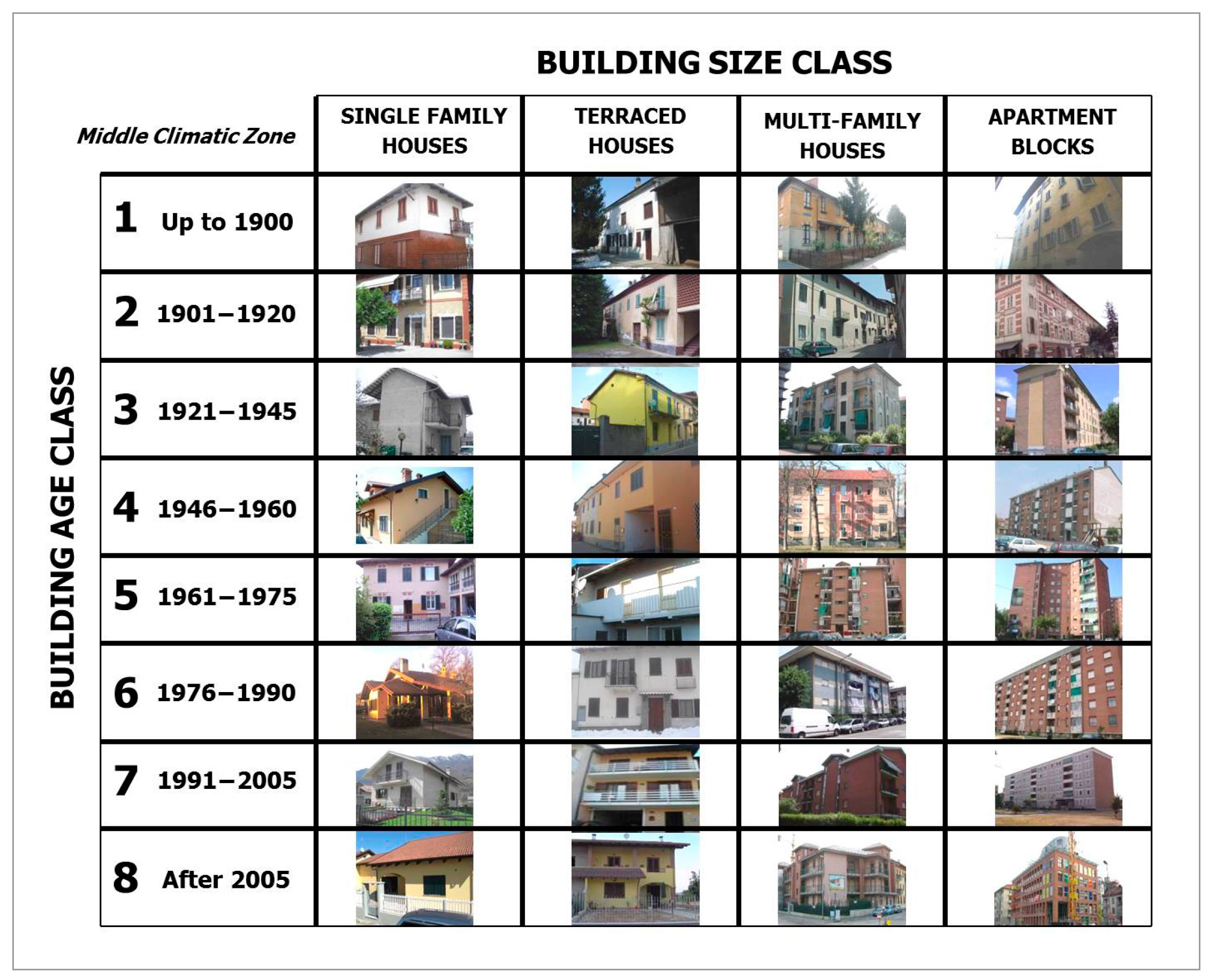
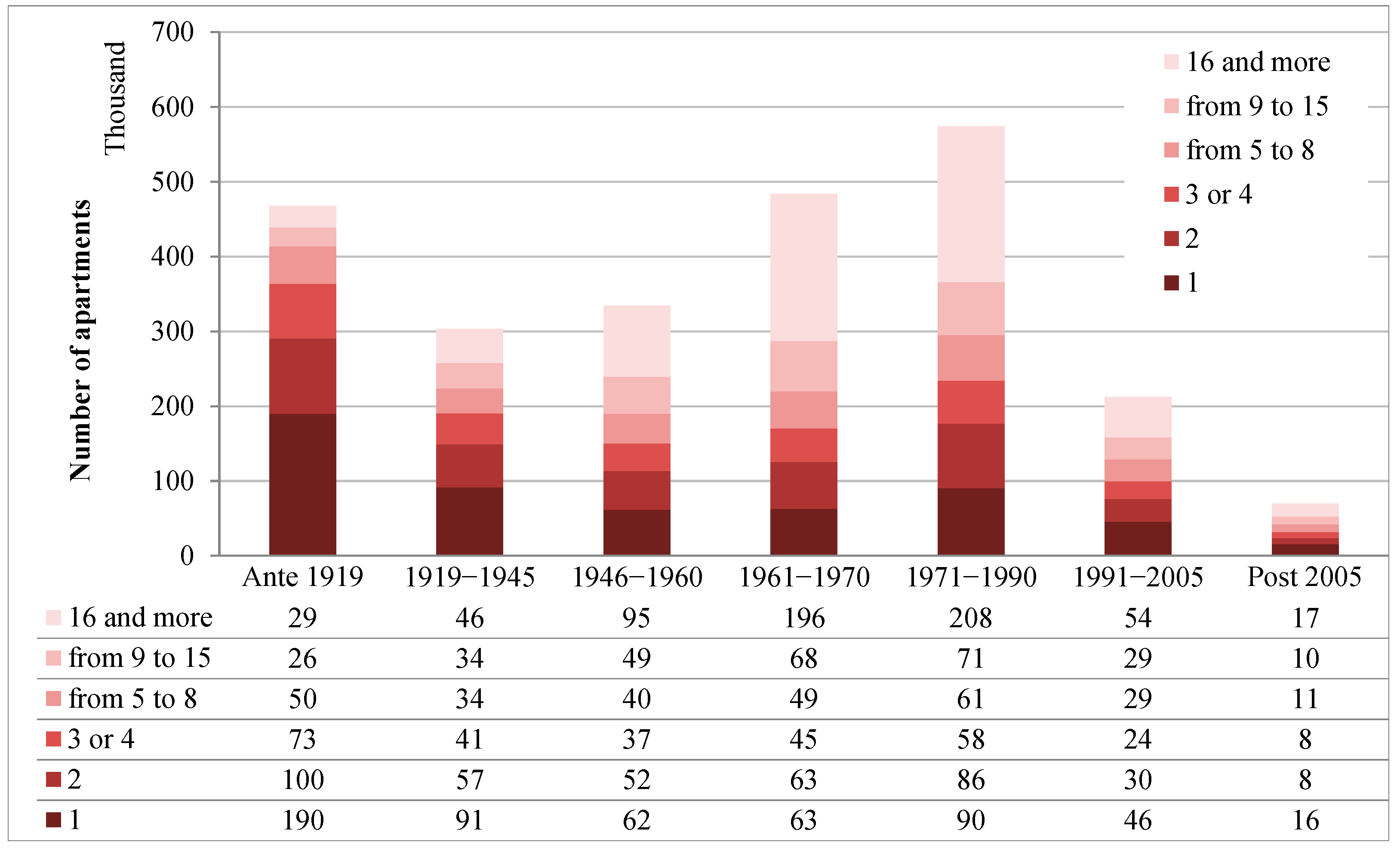
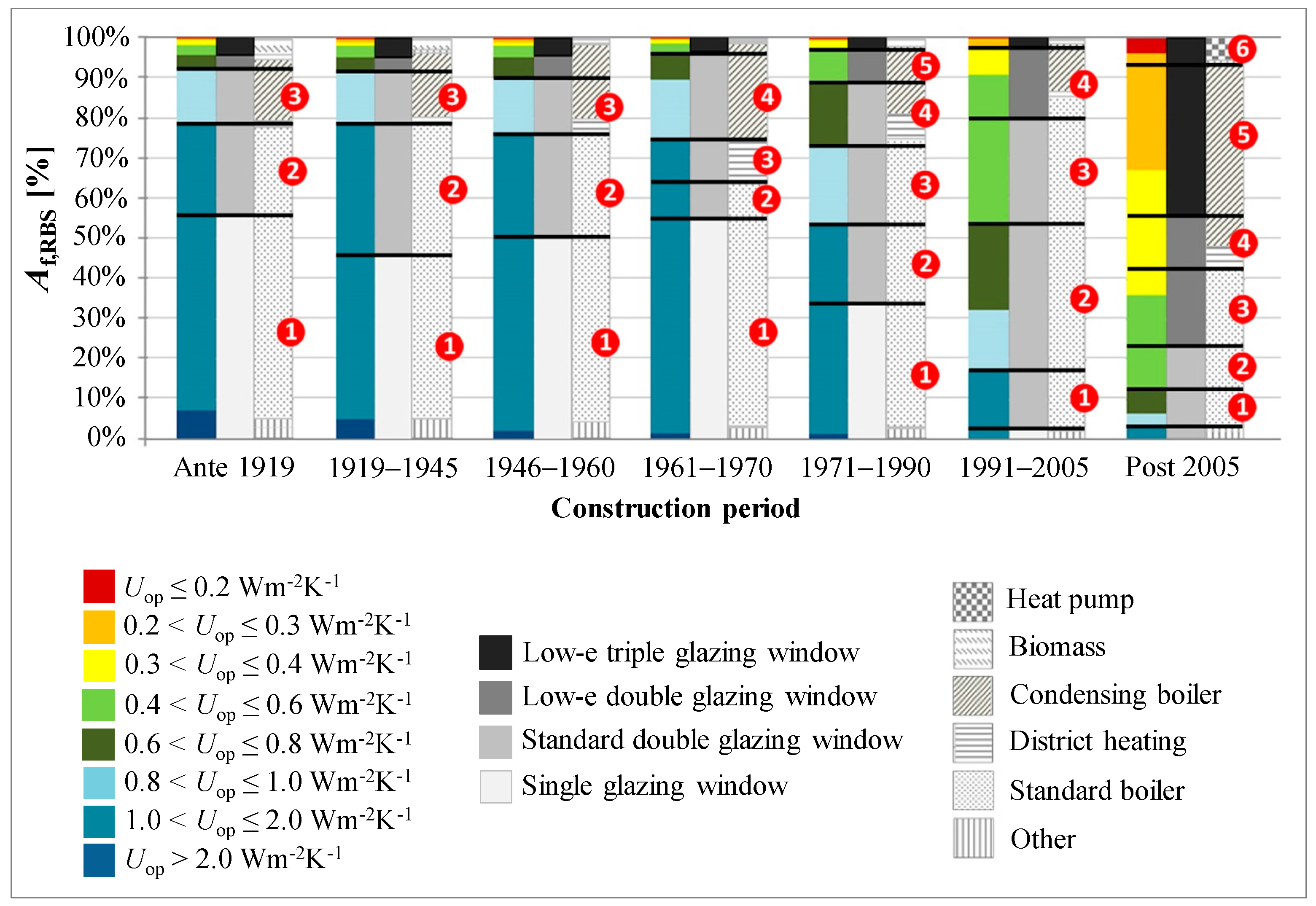

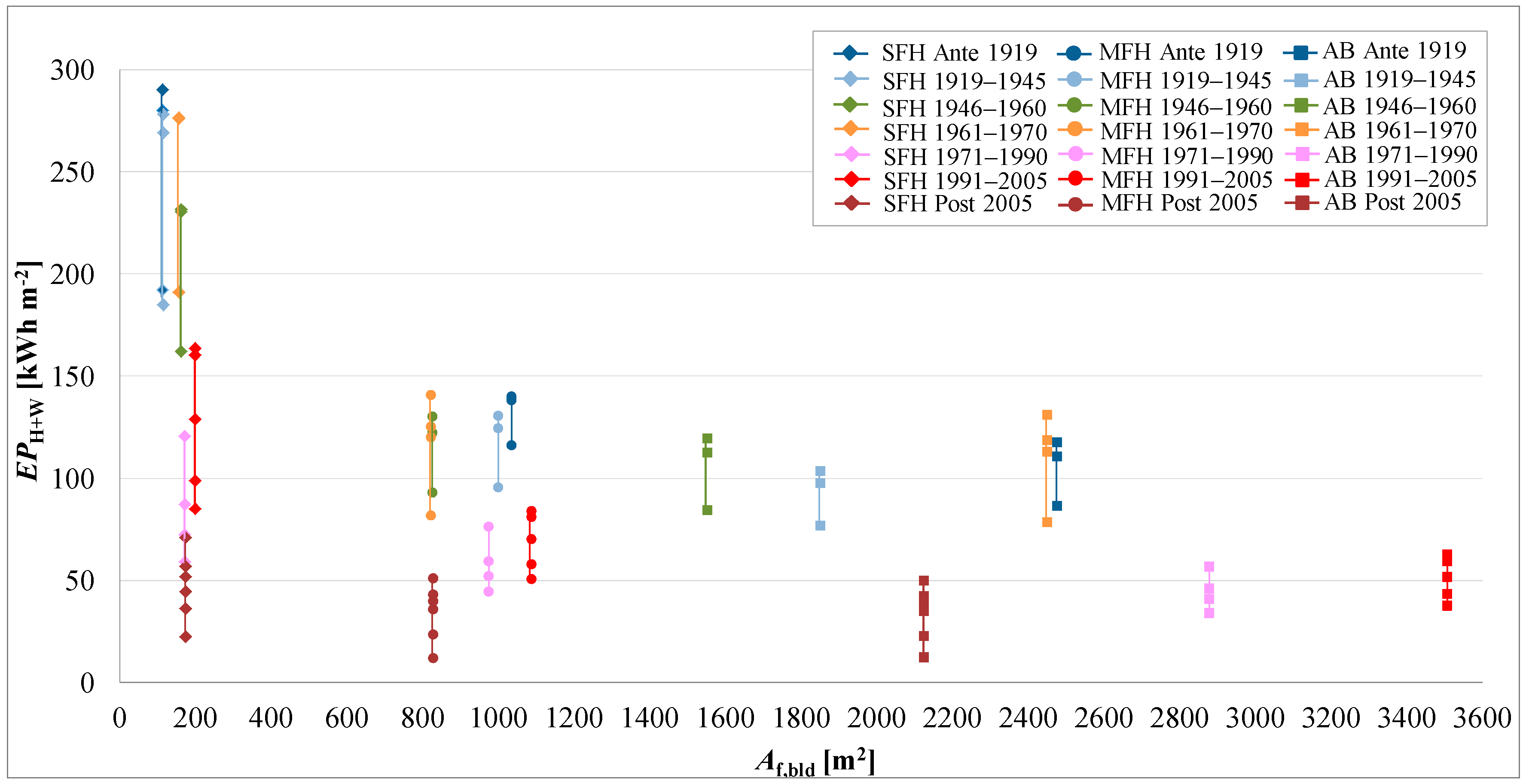
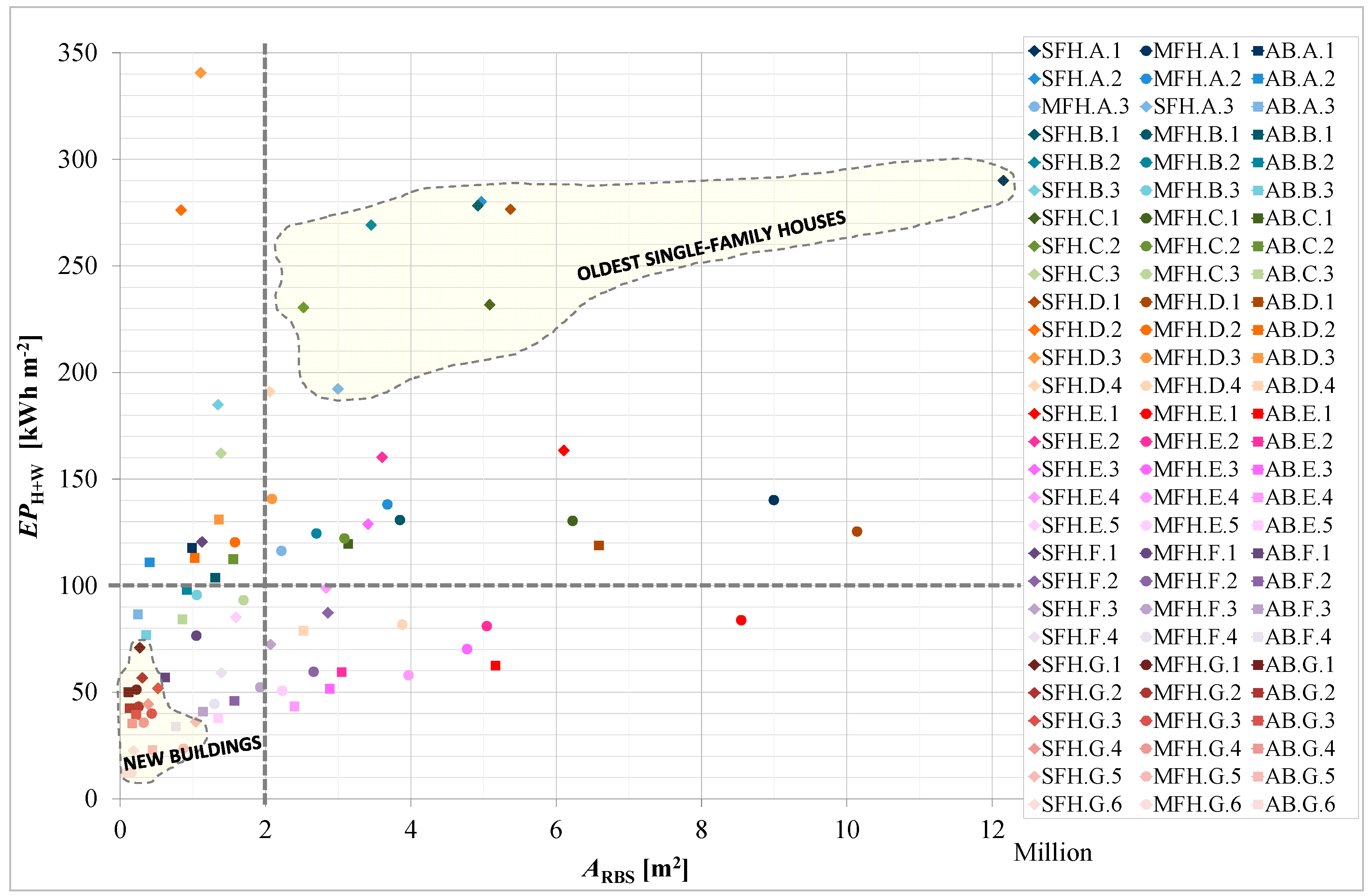
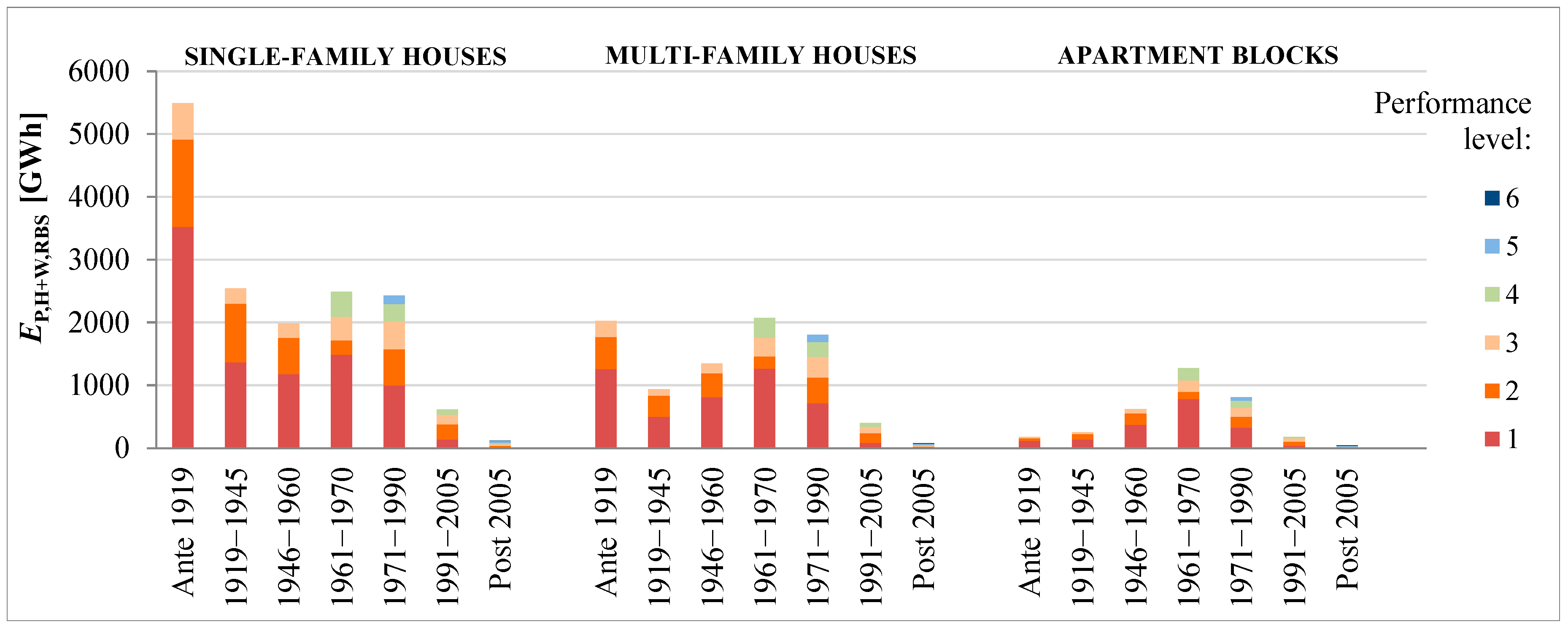

| Parameter | Type 1 | Remark |
|---|---|---|
| Number of residential buildings by construction period | MI | Source: ISTAT, census 2011 [34] |
| Number of apartments by construction period | ||
| Residential building stock floor area by construction period and by building size | MA | Determined as described in Section 3.3 |
| Trend of new buildings | MI | Source: observatory of the real estate market (OMI) [35] |
| U-value of external walls | MI 2 | Source: Piedmont EPCs database |
| Types of windows | ||
| Types of thermal system (i.e., individual or centralized) | ||
| Types of heat generators for space heating and DHW (domestic hot water) | ||
| Energy carriers for space heating and DHW | ||
| Technologies using renewable energy sources | ||
| U-value of bottom and upper floors | MA | Source: IEE-TABULA Project [27] |
| Efficiencies of the subsystems of the technical building systems |
| Building Type 1 | Af,bld [m2] | Af,dwl [m2] | Aenv/Vg [m−1] | Uop [W·m−2·K−1] | Uw [W·m−2·K−1] | Heat Generator Type/Heating System Type 2 | DHW System Type 3 | ηgn,H [-] | ηgn,W 4 [-] | |
|---|---|---|---|---|---|---|---|---|---|---|
| Ante 1919 | SFH.① | 115 | 115 | 0.82 | 1.520 | 5.00 | GSB/CE | CB | 0.85 | 0.83 |
| SFH.② | 1.396 | 3.00 | ||||||||
| SFH.③ | 0.979 | GCB/CE | 0.97 | 0.98 | ||||||
| MFH.① | 1035 | 65 | 0.54 | 1.520 | 5.00 | GSB/IN | CB | 0.88 | 0.84 | |
| MFH.② | 1.396 | 3.00 | ||||||||
| MFH.③ | 0.979 | GCB/IN | 0.97 | 0.98 | ||||||
| AB.① | 2477 | 62 | 0.47 | 1.520 | 5.00 | GSB/IN | CB | 0.88 | 0.84 | |
| AB.② | 1.396 | 3.00 | ||||||||
| AB.③ | 0.979 | GCB/IN | 0.97 | 0.98 | ||||||
| 1919–1945 | SFH.① | 116 | 116 | 0.81 | 1.494 | 5.00 | GSB/CE | CB | 0.85 | 0.83 |
| SFH.② | 1.377 | 3.00 | ||||||||
| SFH.③ | 0.976 | GCB/CE | 0.97 | 0.98 | ||||||
| MFH.① | 1001 | 50 | 0.51 | 1.494 | 5.00 | GSB/IN | CB | 0.88 | 0.84 | |
| MFH.② | 1.377 | 3.00 | ||||||||
| MFH.③ | 0.976 | GCB/IN | 0.97 | 0.98 | ||||||
| AB.① | 1852 | 62 | 0.46 | 1.494 | 5.00 | GSB/IN | CB | 0.88 | 0.84 | |
| AB.② | 1.377 | 3.00 | ||||||||
| AB.③ | 0.976 | GCB/IN | 0.97 | 0.98 | ||||||
| 1946–1960 | SFH.① | 162 | 162 | 0.75 | 1.364 | 5.00 | GSB/CE | CB | 0.85 | 0.83 |
| SFH.② | 1.309 | 3.00 | ||||||||
| SFH.③ | 0.950 | GCB/CE | 0.97 | 0.98 | ||||||
| MFH.① | 827 | 69 | 0.51 | 1.364 | 5.00 | GSB/CE | SPI | 0.85 | 0.80 (0.75) | |
| MFH.② | 1.309 | 3.00 | ||||||||
| MFH.③ | 0.950 | GCB/CE | 0.97 | 0.90 (0.75) | ||||||
| AB.① | 1552 | 65 | 0.46 | 1.364 | 5.00 | GSB/CE | SPI | 0.85 | 0.80 (0.75) | |
| AB.② | 1.309 | 3.00 | ||||||||
| AB.③ | 0.950 | GCB/CE | 0.97 | 0.90 (0.75) | ||||||
| 1961–1970 | SFH.① | 156 | 156 | 0.73 | 1.325 | 5.00 | GSB/CE | CB | 0.85 | 0.83 |
| SFH.② | 1.285 | 3.00 | ||||||||
| SFH.③ | DH/CE | 0.99 | 0.88 | |||||||
| SFH.④ | 0.878 | GCB/CE | 0.97 | 0.98 | ||||||
| MFH.① | 822 | 82 | 0.54 | 1.325 | 5.00 | GSB/CE | SPI | 0.85 | 0.80 (0.75) | |
| MFH.② | 1.285 | 3.00 | ||||||||
| MFH.③ | DH/CE | 0.99 | ||||||||
| MFH.④ | 0.878 | GCB/CE | 0.97 | 0.90 (0.75) | ||||||
| AB.① | 2450 | 61 | 0.46 | 1.325 | 5.00 | GSB/CE | SPI | 0.85 | 0.80 (0.75) | |
| AB.② | 1.285 | 3.00 | ||||||||
| AB.③ | DH/CE | 0.99 | ||||||||
| AB.④ | 0.878 | GCB/CE | 0.97 | 0.90 (0.75) | ||||||
| 1971–1990 | SFH.① | 199 | 199 | 0.72 | 1.337 | 5.00 | GSB/CE | CB | 0.85 | 0.83 |
| SFH.② | 1.275 | 3.00 | ||||||||
| SFH.③ | 0.931 | |||||||||
| SFH.④ | 0.727 | GCB/CE | 0.97 | 0.98 | ||||||
| SFH.⑤ | 0.534 | 2.00 | 0.98 | 0.985 | ||||||
| MFH.① | 1088 | 91 | 0.48 | 1.337 | 5.00 | GSB/IN | CB | 0.88 | 0.84 | |
| MFH.② | 1.275 | 3.00 | ||||||||
| MFH.③ | 0.931 | |||||||||
| MFH.④ | 0.727 | GCB/IN | 0.97 | 0.98 | ||||||
| MFH.⑤ | 0.534 | 2.00 | 0.98 | 0.985 | ||||||
| AB.① | 3506 | 73 | 0.37 | 1.337 | 5.00 | GSB/IN | CB | 0.88 | 0.84 | |
| AB.② | 1.275 | 3.00 | ||||||||
| AB.③ | 0.931 | |||||||||
| AB.④ | 0.727 | GCB/IN | 0.97 | 0.98 | ||||||
| AB.⑤ | 0.534 | 2.00 | 0.98 | 0.985 | ||||||
| 1991–2005 | SFH.① | 172 | 172 | 0.73 | 1.274 | 3.00 | GSB/CE | CB | 0.89 | 0.85 |
| SFH.② | 0.784 | |||||||||
| SFH.③ | 0.533 | |||||||||
| SFH.④ | 0.467 | 2.00 | GCB/CE | 0.98 | 0.985 | |||||
| MFH.① | 975 | 65 | 0.54 | 1.274 | 3.00 | GSB/IN | CB | 0.88 | 0.84 | |
| MFH.② | 0.784 | |||||||||
| MFH.③ | 0.533 | |||||||||
| MFH.④ | 0.467 | 2.00 | GCB/IN | 0.98 | 0.985 | |||||
| AB.① | 2879 | 80 | 0.43 | 1.274 | 3.00 | GSB/IN | CB | 0.88 | 0.84 | |
| AB.② | 0.784 | |||||||||
| AB.③ | 0.533 | |||||||||
| AB.④ | 0.467 | 2.00 | GCB/IN | 0.98 | 0.985 | |||||
| Post 2005 | SFH.① | 174 | 174 | 0.72 | 0.762 | 3.00 | GSB/CE | CB | 0.92 | 0.91 |
| SFH.② | 0.495 | |||||||||
| SFH.③ | 0.445 | 2.00 | ||||||||
| SFH.④ | 0.348 | GCB/CE | 0.98 | 0.985 | ||||||
| SFH.⑤ | 0.290 | 1.50 | 0.99 | 0.99 | ||||||
| SFH.⑥ | 0.212 | EHP/CE | 2.04 (COP) | 2.46 (COP) | ||||||
| MFH.① | 829 | 64 | 0.54 | 0.762 | 3.00 | GSB/CE | CB | 0.94 | 0.91 | |
| MFH.② | 0.495 | |||||||||
| MFH.③ | 0.445 | 2.00 | ||||||||
| MFH.④ | 0.348 | GCB/CE | 0.98 | 0.985 | ||||||
| MFH.⑤ | 0.290 | 1.50 | 0.99 | 0.99 | ||||||
| MFH.⑥ | 0.212 | EHP/CE | 2.14 (COP) | 2.55 (COP) | ||||||
| AB.① | 2125 | 69 | 0.40 | 0.762 | 3.00 | GSB/CE | CB | 0.94 | 0.91 | |
| AB.② | 0.495 | |||||||||
| AB.③ | 0.445 | 2.00 | ||||||||
| AB.④ | 0.348 | GCB/CE | 0.98 | 0.985 | ||||||
| AB.⑤ | 0.290 | 1.50 | 0.99 | 0.99 | ||||||
| AB.⑥ | 0.212 | EHP/CE | 2.14 (COP) | 2.55 (COP) | ||||||
| Year | HDD [°Cd] | Edel,H+W,ff,R [TWh] |
|---|---|---|
| 1990 | 2374 | 23.60 |
| 1995 | 2367 | 23.28 |
| 2000 | 2316 | 22.62 |
| 2001 | 2361 | 23.48 |
| 2002 | 2274 | 21.90 |
| 2004 | 2317 | 22.73 |
| 2005 | 2414 | 24.29 |
| 2006 | 2239 | 22.49 |
| 2008 | 2155 | 20.91 |
| 2009 | 2456 | 24.56 |
| 2010 | 2508 | 25.65 |
| 2011 | 2373 | 23.72 |
© 2017 by the authors. Licensee MDPI, Basel, Switzerland. This article is an open access article distributed under the terms and conditions of the Creative Commons Attribution (CC BY) license (http://creativecommons.org/licenses/by/4.0/).
Share and Cite
Ballarini, I.; Corrado, V. A New Methodology for Assessing the Energy Consumption of Building Stocks. Energies 2017, 10, 1102. https://doi.org/10.3390/en10081102
Ballarini I, Corrado V. A New Methodology for Assessing the Energy Consumption of Building Stocks. Energies. 2017; 10(8):1102. https://doi.org/10.3390/en10081102
Chicago/Turabian StyleBallarini, Ilaria, and Vincenzo Corrado. 2017. "A New Methodology for Assessing the Energy Consumption of Building Stocks" Energies 10, no. 8: 1102. https://doi.org/10.3390/en10081102





